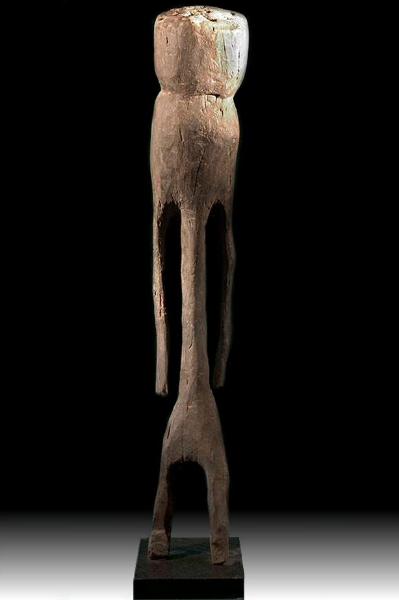
| If you came to this page looking for another topic besides Moba figures, click below to go to the "You be the judge ARCHIVES" |
| You be the judge... Moba tchitcheri I picked the topic of the Moba figures because it was something that I knew absolutely nothing about. You see them commonly referred to as "Moba togo" figures, and that is what I always thought they were. As you will see, the Moba people were from Ghana and also from Togo but the figures are actually "tchitcheri" figures, they are divided into 3 different classifications. They seem to be a popular item among collectors and almost every time I see one on eBay it will sell and usually sell for a few hundred dollars to many hundred dollars. How does a collector know that they are getting a good piece if you're buying one of these? Right now, there are several of the larger tchitcheri figures at auction and below is one of similar size. These figures might be a little harder to classify as "authentic" or not authentic because they do not have some of the detailed or unique carving styles like the Luba that you can pick out stylistic differences in that don't look right. As far as patina goes...these figures are sometimes placed outside and sometimes in the vestibule of the house and sometimes inside in personal shrines so the patina can be varied. |
| Information on the Moba tchitcheri |
| In Moba communities of northeastern Ghana and northwestern Togo, diviners influence and direct the commissioning, design, and ritual treatment of sculptural forms created for several different kinds of domestic shrines.1 Both the scale and the relatively abstract form of this particular work suggest that it was probably owned by an extended family or clan. It was associated with their origins and played a vital role in assuring their collective well-being. In Moba society, when ancestral offerings fail to provide an individual with desired relief, an earth oracle with an established reputation is consulted.2 In advising individuals, families, or clans, Moba diviners prescribe tchitcheri figures to fortify their clients and improve their lives. Such works increase the efficacy of the ritual actions performed at shrines by calling forth positive ancestral influences. They are protective and promote health and prosperity on a range of different levels. When a particular problem disrupted an individual's life, diviners often recommended the addition of a figurative work to that person's private altar. Similarly, problems of broader concern, such as diseased livestock, poor harvests, or infertility, often led diviners to prescribe that a larger work be commissioned for a family shrine. Challenging an account by Leo Frobenius from the turn of the century, which suggested that the owner of such a work carved it him- or herself, Christine Mullen Kreamer determined that it was invariably made by a specialist. Although in Moba society, wood carving is a skill that all may acquire, tchitcheri may be fashioned only by individuals whose fathers are diviners. Carving tchitcheri is considered a delicate and highly dangerous operation, and diviners give their sons special protection needed for the creation of such ritually charged objects. Those who transgress this sanction are thought to risk blindness or insanity.3 Three different genres of tchitcheri may be distinguished by their patronage, contextual placement, scale, and degree of abstraction. The smallest of these, yendu tchitcheri, are placed in personal shrines, which all adults possess. They do not represent any particular person or ancestor but are considered an individual's direct link with God. Middle-size bawoong tchitcheri (between 25 and 90 centimeters high) are designed for household shrines situated prominently in the vestibule of a family compound. These figures represent recent ancestors, such as the parents or grandparents of current compound leaders (no more than three or four generations removed), whom the diviner advises the family to petition. Because the figures correspond to known ancestors, they are more detailed in representing bodily and facial features. The work shown here falls into the category of tchitcheri sakwa, which evoke and are named after a clan's founding member. The Moba are subsistence agriculturalists, and rituals are conducted before planting and harvest by the family's eldest male member, who applies libations to its sakwa commemorating the founding ancestor.4 Stylistically, sakwa fall between the extremely abbreviated, faceless, anonymous yendu and the more specifically identifiable bawoong portraits. These monumental works are prominently placed outside, in the household yard. Although the features of a family's sakwa become abraded by the elements, it stands from one generation to the next as an indelible marker of its spiritual life. No contemporary works of this kind have been commissioned, and oral history and the condition of some surviving works suggest that they may be several centuries old. The highly standardized design of tchitcheri reduces the human figure to an elemental form. Attenuated arms may either form a single unit with the torso or be detached at chest level. Minimal attention is given to facial features, details such as hands and feet are generally omitted, and only occasionally is gender suggested. This extremely reductive polelike figure is crowned by a rounded knoblike head with a blank expression. The upper body forms a unified, continuous surface, with its arms held at its sides along the length of the torso. The trunk is represented as a recessed rectangle with raised nipples and umbilicus; at its base, it narrows and then flares outward slightly to suggest hips. Below, clothespinlike legs are carved as two separate prongs that taper off into narrowed stems. Despite an emphasis on bilateral symmetry, the figure leans very gently to one side. Throughout the weathered surface, abrasion and splits reveal the effects wrought upon the work over time. Information is taken from: http://www.metmuseum.org/explore/oracle/figures39.html |
| 1. Moba sculptural forms have been classified as belonging to a substyle related to peoples of Gur-speaking heritage who have settled from the western Sudan through the Benue River basin; Sieber and Rubin 1968 and Roy 1978, both cited in Christine Mullen Kreamer, "Moba Shrine Figures," African Arts 20, no. 2. p. 53. This suggests that a common cultural legacy underlies the formal affinity between the work shown here and the Mumuye figure in cat. no. 6. 2. Frobenius 1913, p. 430, quoted in Kreamer, "Moba Shrine Figures," p. 53. 3. Kreamer, "Moba Shrine Figures," p. 53. 4. Ibid., p. 54. |
| 39. Clan Shrine Figure (Tchitcheri Sakwa) Moba, Togo Wood; H. 135 cm (53 1/8 in.) 19th–20th century The Horstmann Collection, Zug, Switzerland Image is from : http://www.metmuseum.org/explore/oracle/figures39.html |

|
| Below are some interesting photos I came across while researching the Moba figures showing the Moba people and the tchitcheri figures. The pictures are from the following links: http://www.geocities.com/djembesorg/ |









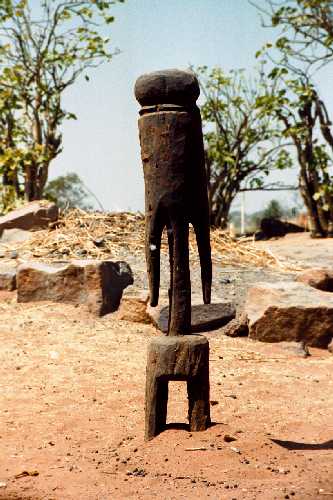


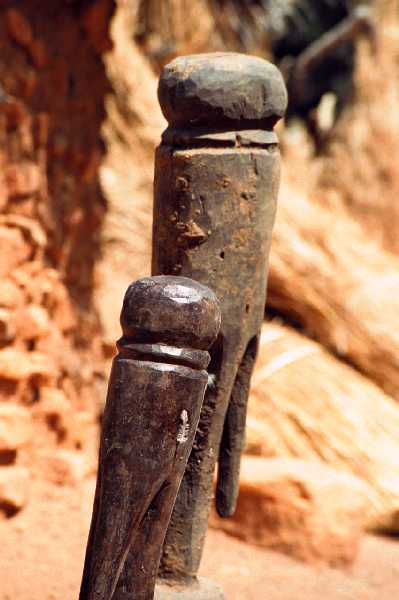

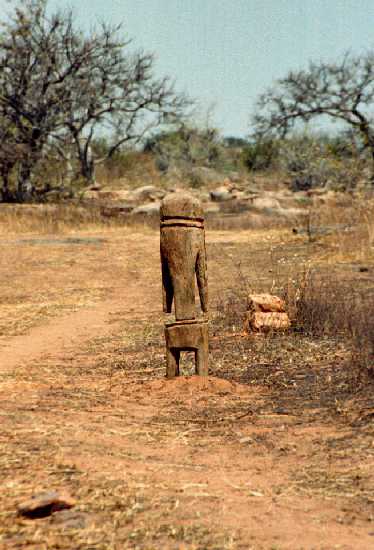

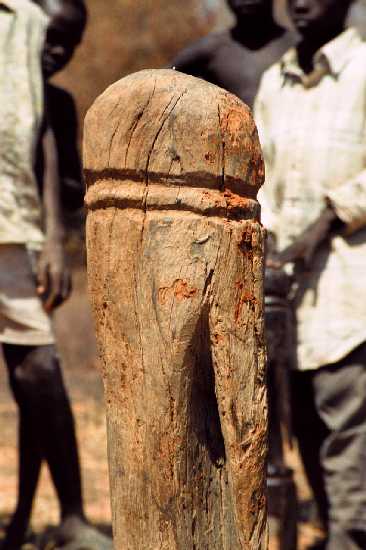
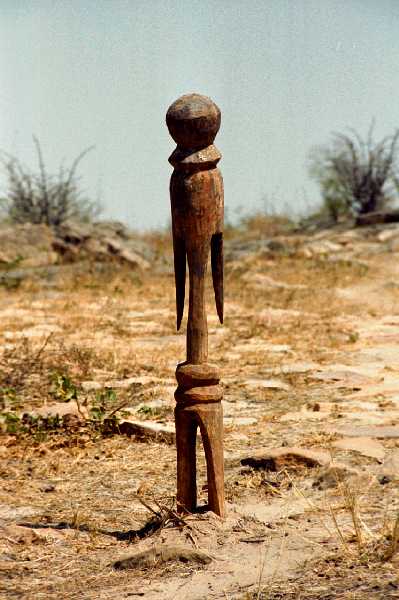
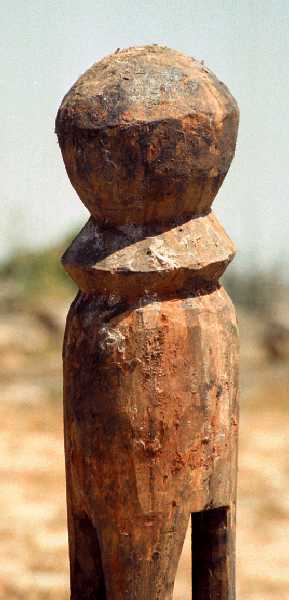
| Rand African Art home page Educational resources page Click here to see the Moba tchitcheri figure in my collection shown below. |
|
